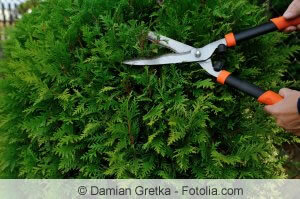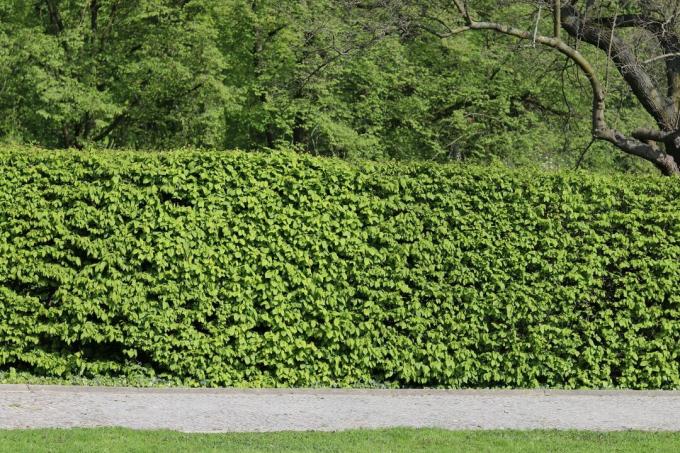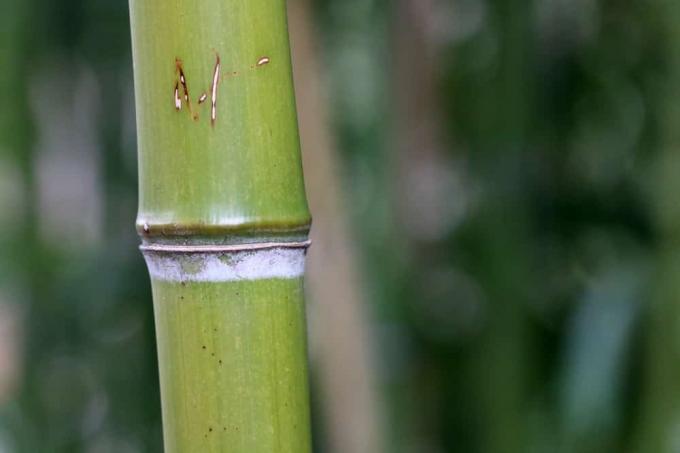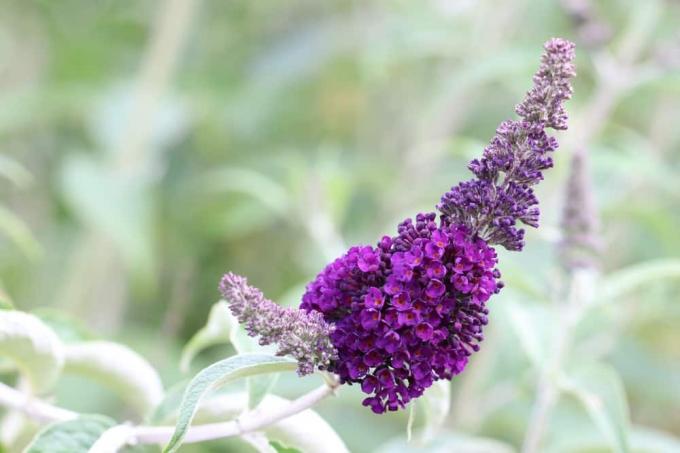

Table of contents
- location and soil
- fertilizing and watering
- planting
- multiply
- Cut
- hibernate
- Thuja and the ecology
- An enrichment for the home garden
- Editor's conclusion
- Things worth knowing about Thuja occidentalis 'Smaragd'
- use
- Care and pruning of the Thuja smaragd
With its slender, upright growth, Thuja occidentalis Smaragd is one of the classic trees of life. In many gardens, the Thuja species with the aromatic, fragrant needles is cultivated as an evergreen hedge plant. The wood retains its dense, light green foliage even in winter and does not turn brown like other conifers. The tree of life is considered to be robust and vigorous, but certain requirements in terms of location and care must still be met. The right trimming in particular is a small challenge for hobby gardeners.
location and soil
The popular plants are extremely easy to care for and make little demands on the planting site and soil. Arborvitae are extremely light-hungry, a shady and too dark location impairs the dense and lush growth of the evergreen plants. Extremely long and light-growing branches are the clear result of a lack of light. Choose a full sun to light, partially shaded spot in the garden for the shrubs. When choosing a location, also note that the plants can reach a height of between 4 and 8 meters. The substrate should have four important criteria:
- profound
- rich in humus
- clayey
- light lime content
The pressure of heavy soil retards root growth. If necessary, loosen up the soil over a large area with gravel. Thujen are extremely moisture-loving, a fact that should also be considered when choosing the right substrate. Clay stores water just like a thick layer of bark mulch.
fertilizing and watering
When it comes to the supply of nutrients, the tree of life is anything but frugal. In spring and late summer, mulch the soil sufficiently and work in a mixture of compost, manure and horn shavings. A special conifer fertilizer from specialist shops also supports and promotes the growth and health of the slow-growing trees. Solitary and hedge plants have different requirements: if thujas are cultivated as a dense privacy hedge, the plants compete with each other for water and minerals. Young hedge plants in particular therefore benefit from a long-term fertilizer during the main growing season.
Thuja occidentalis Smaragd is one of the few plants that can cope well with waterlogging. In East Asia and North America, the plant is often found on bank edges and in swampy areas. You have to water all year round, even in winter the root ball of the tree of life must not dry out. Even older plants are sensitive to drought and can suffer massive damage. In winter you should protect the moisture in the soil from evaporation with bark mulch, brushwood or withered leaves. At the same time, this material supplies the thujas with valuable nutrients. In the cold season, if possible, watering is done on frost-free days. Use lukewarm water in sufficient quantities to allow the liquid to reach the roots even in frozen soil.
planting
The ideal time for planting is between March and May. Planted in spring, the tree of life can sufficiently acclimate to the new location and prepare for the cold season. Exactly how you proceed depends on the type of cultivation. The evergreen deciduous trees are adaptable and, as a solitary plant, offer an interesting eye-catcher in your own garden. Due to the narrow and densely branched growth, thujas are also well suited as hedge plants. At any time of the year, the plants shield the garden from the prying eyes of outsiders. For solitary plants, proceed as follows:
- Dig a planting hole twice the size of the root ball.
- Mix the substrate with hummus and horn shavings.
- Spread a thin layer of compost directly in the planting hole.
- Insert thuja up to the upper root neck.
- Backfill soil and sludge firmly.
In the case of solitary trees of life, you should create a watering edge. The soil is laid out in a slightly conical shape around the trunk of the tree and flattened at the top. This spot makes it easier for you to water and fertilize. Keep this area free of weeds and don't plant any ground cover plants. This option is not available for hedge plants due to the lack of space.

With a little trick you can create privacy hedges: Even before the spade is used, you should mark out the covered area. This gives you a rough overview and allows you to easily correct errors. You should keep a sufficient distance to neighboring properties and also to the street. Then dig a trench about 50 cm wide. Its depth depends on the size of the roots. With Thuja occidentalis Smaragd, the minimum distance between the individual plants is about 35 - 45 cm. Sludge the shrubs sufficiently after planting, you can do without fertilizer in the first two months.
Tip:
Before planting, take the small trees of life out of the tub and place the root ball in a container filled with water for 24 hours.
multiply
The propagation of conifers is laborious and rarely crowned with success. The best way to do this is through the seeds of the plant. Thuja occidentalis belongs to the cold germs, the seed has to go through a cold phase for successful germination. Avoid storing them in the refrigerator and sow the seeds in autumn. The cultivation can also be done in a planter in the garden. Under no circumstances should you lose patience, because it can take several months for the first sprouts to appear.
Cut
The Thuja tree of life is an extremely robust plant. However, pruning done incorrectly can cause lasting damage to the wood. Regular pruning is necessary, especially for hedge plants, so that they remain in shape and have an even appearance. Proceed with caution and never remove the old wood. Because the plants do not sprout again here, any bare spots that have formed do not regenerate. The easiest way to avoid this problem is to cut young arborvitae twice a year. Only cut back a few centimeters at a time. The first pruning takes place in the spring, even before the wood begins to sprout more twigs and leaves. The second pruning is done in late summer.
hibernate
Overwintering is no problem for Thuja occidentalis Smaragd, because even young plants survive double-digit minus temperatures. However, you can apply a protective layer of bark mulch or brushwood. This warms the soil and at the same time prevents the irrigation water from evaporating too quickly. In contrast to many other Thuja species, the foliage of Thuja occidentalis Smaragd does not turn brown in winter, but shines in its light green splendor all year round.
Thuja and the ecology
The Thuja, and especially the Thuja Smaragd, are among the most popular property edging plants in Germany because of their above-mentioned positive properties. However, you might find some not very friendly regarding the arborvitae like the Thuja Smaragd Considerations will be read when you learn about hedge plants and their properties and characteristics inform.
In fact, coniferous hedges generally have less value to the natural environment than deciduous hedges because they are much less attractive to birds Offer opportunities to build their nests and with their needle dress nests would not hide so well if a bird did decide to build a nest would decide. Conifers, which have their home in completely different areas of the world, are doubly uninteresting for our small animal world because they do not provide them with any food, etc. provide. However, if you plant enough native and flowering (hedge) trees in the rest of your garden, You don't have to worry that the birds and insects in your garden will run out of food find.

An enrichment for the home garden
In summary, it can be stated that the Thuja Smaragd is excellent for property limitations in the visible area in front of modern buildings, where it suits the design and also makes a very neat impression. With regard to the ecological balance of the environment, it is advisable to plant such a hedge but only if the overall design of the house garden is not exclusively aimed at foreign guests limited. However, you have to live with the fact that you will probably not win an innovation award in garden design with a thuja hedge.
Editor's conclusion
Thuja occidentalis Smaragd is a robust and extremely popular tree of life variety. The conifers are robust and have a dense growth. However, under no circumstances should you leave the trees to themselves. A regular pruning is just as necessary as the year-round supply of water. If you value privacy in the garden or at least want to shield individual areas from prying eyes, the evergreen tree of life is the right choice.
Things worth knowing about Thuja occidentalis 'Smaragd'
- The Thuja Smaragd is a very popular one tree of lifecultivar originally native to northeastern United States and Canada.
- Their emerald green, slightly shiny, odorless needles are particularly attractive and stay in the winter fresh green.
- Its growth is cone-shaped and slender, the branches are dense and compact.
- The slightly higher purchase price is quickly compensated for by the relatively low maintenance effort.
- This thuja is ideal for creating an opaque Hedge, for property demarcation, but also for individual planting.
use
The range of uses is extremely wide, as it fits in equally harmoniously in rural areas as well as in parks and villa gardens. perennial borders it serves as a highly decorative background. Best planting time is the end of summer in order to be well rooted before the onset of winter - and thus protected against signs of drying out.
Care and pruning of the Thuja smaragd
- Thuja care: This tree of life loves fresh, permeable, slightly acidic to alkaline soil and a sunny to partially shaded location. Water enough! Never let it dry out! Best always hand high mulch. It is an extremely undemanding, robust plant, but sensitive to dry air and soil as well as road salt. With proper preparation (watering well in autumn) it is absolutely frost hardy.
- Thuja–cut hedges: Because of their slow growth (10-20 cm per year), emerald hedges do not need to be cut for years. And if so, then only for height correction. Unpruned, this strain can reach four to six meters in height.
- Thuja fertilization: Thujas should generally not be fertilized in the year of planting. This is not recommended, especially with cut root balls. The following spring, fertilizers with an organic basis and special fertilizers for conifers are suitable to support the thuja trees in their budding.
If thuja get brown needles, this is not necessarily a sign of disease, but of drought. The soil should always be well watered and also well drained. Its pH value should be in the slightly acidic to alkaline range.
 garden editorial
garden editorial I write about everything that interests me in my garden.
Learn more about hedges

Hornbeam hedge: 17 tips for care
Hornbeams (Carpinus betulus) are most commonly used as topiaries or hedge plants. They are actually not beeches at all, but belong to the birch family. The hornbeam is very robust, easy to care for and, in contrast to the common beech, not poisonous.

How fast does bamboo grow? | Information about growth
In domestic gardens, bamboo is usually used as a privacy screen or as a decorative solitary plant. The rapid growth, which can reach several cm a day, is impressive. It depends on the bamboo variety, care and the prevailing microclimate.

How fast does cherry laurel grow? | accelerate growth
The cherry laurel is a fast and densely growing tree. After planting, it usually only takes a few years for the young plants to grow into a tall, dense and evergreen hedge. In addition, growth can be accelerated by additional precautions.

Creating a mixed colorful hedge: 9 ideas for a mixed hedge
If you don't like it monotonous, you can also create a mixed hedge instead of a hedge from a single, evergreen plant species. There is a wide range of colorful hedges to choose from. There are special flowering hedges, ones for birds, scented ones, or for insects and butterflies.

Yellow cypress | 9 tips for care, pruning & growth
The yellow cypress is one of the most common hedge plants in our gardens. No wonder: it combines a great look with an opaque growth. How to properly care for them, cut them and generally promote their growth is here.

Thuja brabant turns brown or yellow: what to do? 8 common causes
When Thuja brabant turns yellow or brown, various factors can be responsible - but care mistakes are often the trigger. We reveal which factors are involved and how they can be counteracted.
